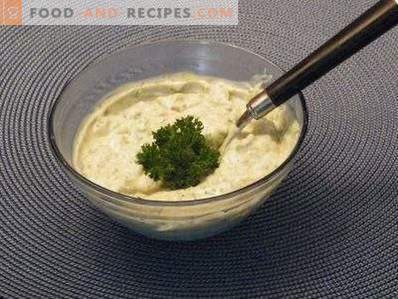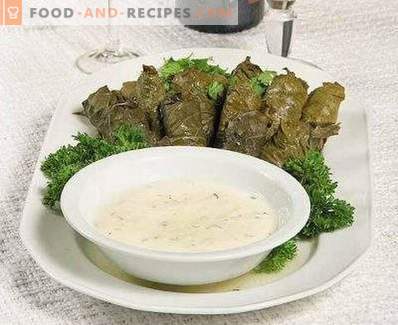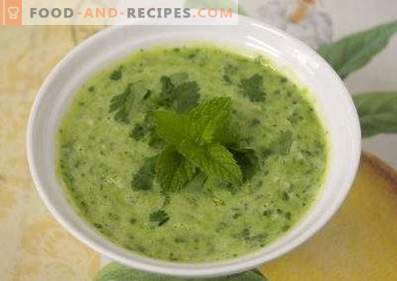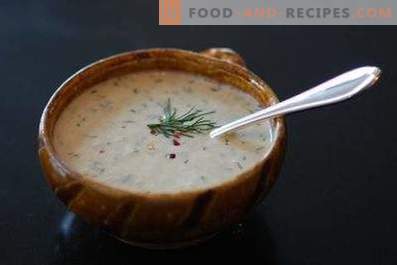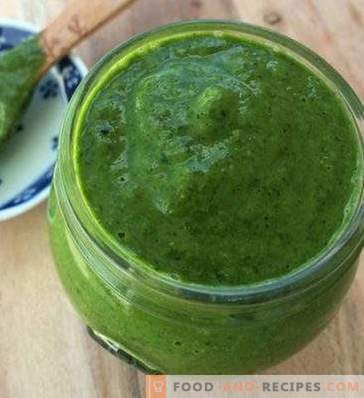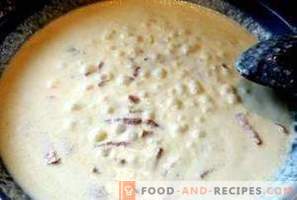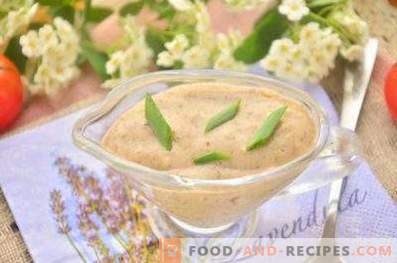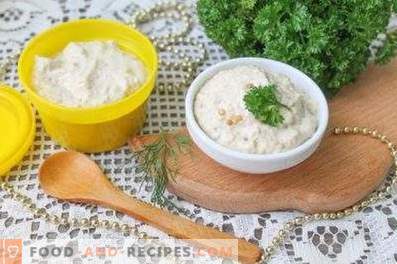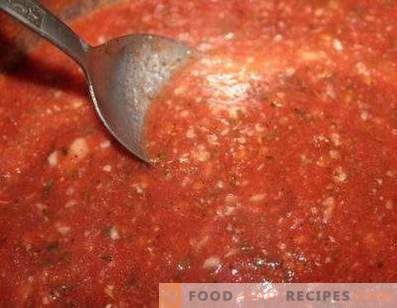
French cuisine is famous for a large number of various sauces. Some of them prepare for specific dishes, others perfectly complement the taste of several dishes, others - are universal or almost universal. Bearn sauce belongs to the third group. Most often it is served with meat and poultry, but no less well it is in harmony with fish, seafood, vegetables. The versatility of the béarne sauce is also due to the fact that it is good both hot and cold. However, it is necessary to get it out of the refrigerator in advance so that it warms at least to room temperature, otherwise its consistency will be too thick and it will be difficult for them to pour the dish. By itself, the sauce is quite thick and lush, has a pleasant creamy tint. It is prepared on the basis of white wine vinegar, butter and raw yolks, with the addition of a certain set of spices and spices that give the liquid seasoning a unique taste and aroma.
Cooking Features
For the preparation of some sauces, high culinary skills are required, while others are prepared quite simply. Sauce béarnaise (also called béarn sauce) is of medium difficulty. This means that in its preparation it is necessary to strictly observe the technology and know a few subtleties. In this case, an inexperienced cook will be able to cope with the task.
- Raw yolks are required to make the sauce. Preference should be given to the eggs of domestic chickens, as their yolks are brighter and give the sauce a more pleasant shade. It is very important to be aware of the health of the laying hen so as not to become infected with salmonellosis. If you do not have such data and bought eggs at the store, you should thoroughly wash them before using them using soap and a sponge.
- The traditional recipe for a bearnaise sauce requires the use of shallots. It has a more subtle and noble taste compared to onions, but can be replaced by them if desired. It will not seriously affect the taste of the prepared sauce.
- Another important ingredient is white wine vinegar. If you replace it with red vinegar, it can affect the color of the finished sauce. Therefore, in the absence of white wine vinegar in the house, it is better to replace it with apple one.
- The fourth ingredient is butter. It is required for cooking sauce most of all, and the quality of the finished dish depends on its quality. Replace butter spread in this case will not work.
- We should also mention the spices that are traditionally used to make béarnaise sauce. This is an etragon, it is tarragon, and chervil is a spicy herb that looks to us all well-known parsley by its appearance, taste and aroma. It is difficult to find an adequate substitute for tarragon, but you can substitute chervil with parsley without even thinking.
- You need to prepare the béarna sauce in a water bath, gradually introducing the ingredients and constantly beating the sauce with a whisk. If you put a bowl with sauce on the fire, it will immediately turn into an omelet. If you try to mix everything at once to speed up the process, the sauce will flake.
- If, despite your best efforts, the sauce is still stratified after cooking, you can add crushed ice to it and beat it. If this does not work, try adding another yolk, and then strain the sauce.
Serve bearnaise sauce to meat and fish dishes, poultry dishes, and vegetables. He will give their taste unusual shades.
Classic béarne sauce recipe
Composition:
- shallot - 30 g (or 25 g of onions);
- butter - 150 g;
- water - 80 ml;
- white wine vinegar (6 percent) - 40 ml;
- white ground pepper - a pinch;
- chicken egg yolks - 2 pcs .;
- fresh chervil or parsley - 30 g (10 g can be replaced with dried);
- fresh tarragon (tarragon) - 15 g (you can replace 5 g of dried).
Preparation Method:
- Wash and peel the onion, cut it into very small pieces.
- Separate yolks from proteins. Proteins for the preparation of the sauce will not be required, but they should not be thrown away, because they can serve as a basis for preparing other delicious dishes.
- Melt the butter to a liquid state and let it cool for a while to a temperature just above room temperature.
- Finely chop fresh greens, mix.
- Place the onions and peppers in a small bowl or in a frying pan.
- Mix vinegar with two tablespoons of water. Pour onion with this mixture, put on low heat. When the mixture boils out about half or even a little more, add the remaining water, bring the mixture to a boil. Put the onion in a container in which you will be preparing the sauce in a water bath.
- Combine chicken yolks with the third part of melted butter, whisk. Pour into a bowl of onions, whisk again and put in a water bath.
- Heat, beating with a whisk, to about 40 degrees. Enter butter in small portions, continuing to beat.
- When the sauce thickens sufficiently, add herbs and stir in it. At the same stage, the sauce can be slightly salted.
Despite the fact that the bearnaise sauce can be served cold, the temperature of about 60 degrees is considered optimal for it. You can warm it in a water bath. It is impossible to warm up the sauce in the microwave, as in this case it will separate and lose its attractiveness.
Adapted bearnaise sauce recipe
Composition:
- onion bulb - 60 g;
- apple cider vinegar (6%) - 100 ml;
- chicken egg yolks - 2 pcs .;
- butter - 0, 24 kg;
- water - 20 ml;
- black ground pepper - 5 g;
- tarragon - 3 branches;
- thyme - 1 sprig;
- bay leaf - 1 pc.
Preparation Method:
- Remove peel from onion, chop it finely.
- At the tarragon, tear off the leaves, set aside.
- In a small container, fold the onion, bay leaf, sprig of thyme and stems of tarragon (without leaves), add pepper. Pour it all with vinegar and set on low heat. Boil the mixture about half. Strain through a sieve.
- Beat yolks, adding a spoonful of cold water and vinegar cooled to room temperature, saturated with the aromas of spicy herbs.
- Heat in a water bath. In small pieces, add butter, each time beating the sauce until smooth.
- When the oil is finished, add the chopped tarragon leaves into the sauce, stir and remove from the water bath.
The sauce prepared according to this recipe has the same consistency as the original béarna sauce, and its taste is very similar to it, slightly more spicy. For a milder taste and an even more pleasant aroma, some housewives replace part of the vinegar with lemon juice, but not more than half.
The béarne sauce, which has a delicate texture and creamy taste, is an excellent addition to any dish, it sets off the taste of lean meat and poultry especially well.


